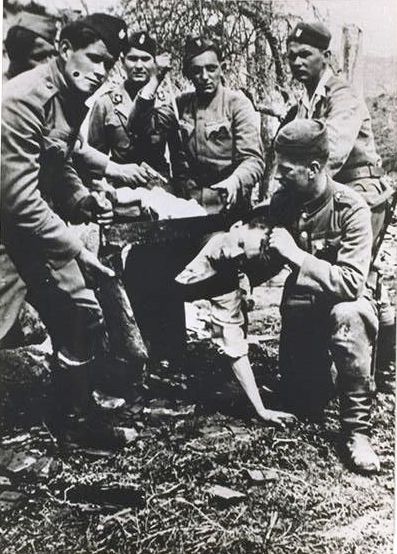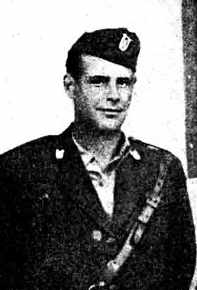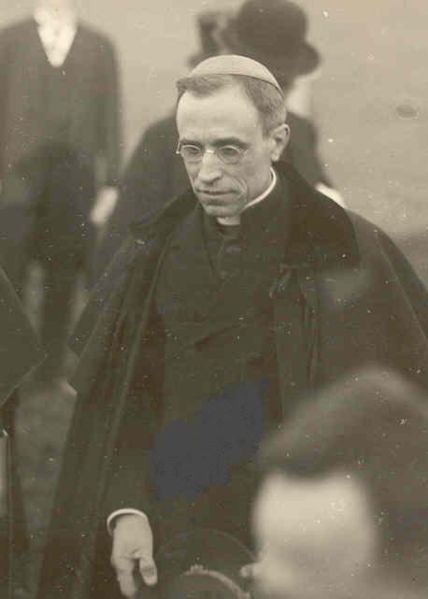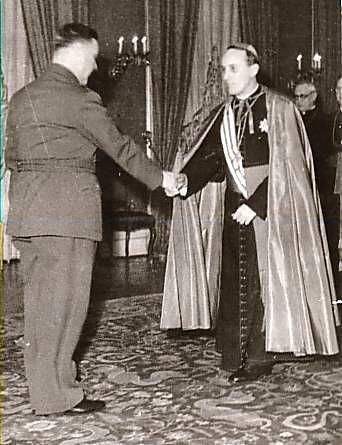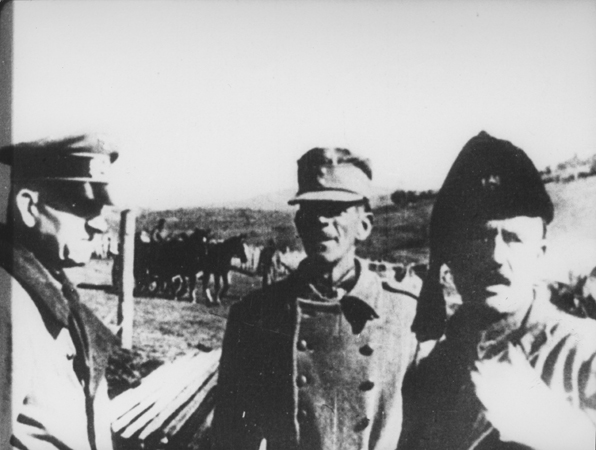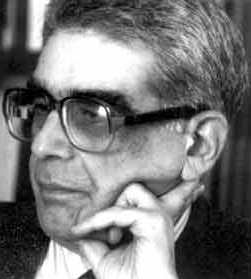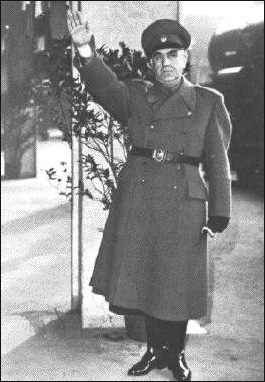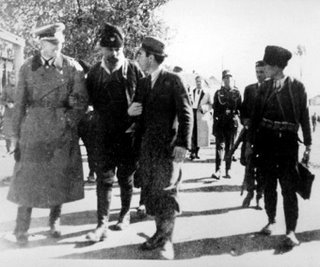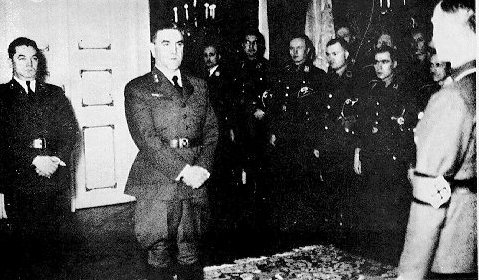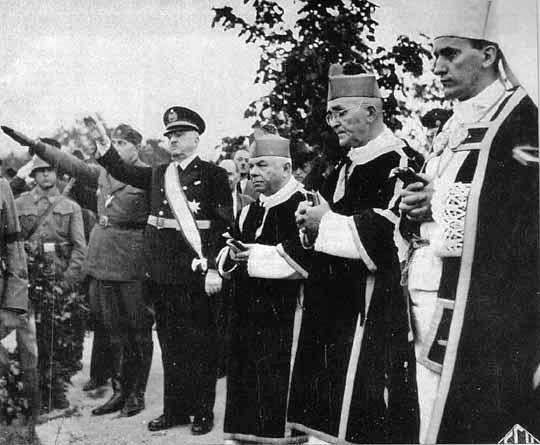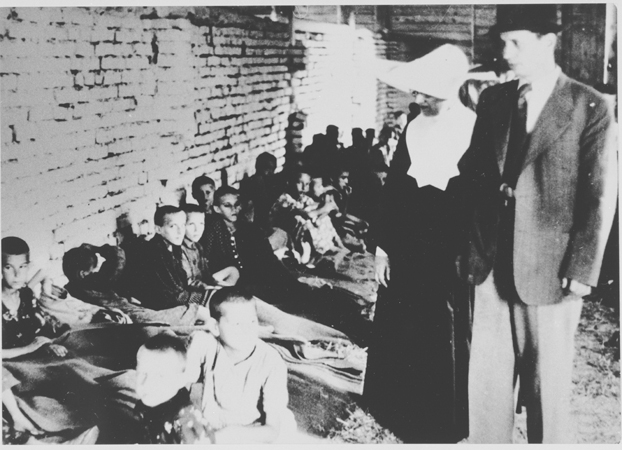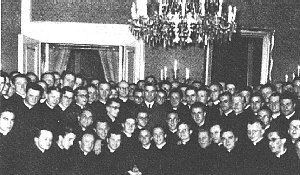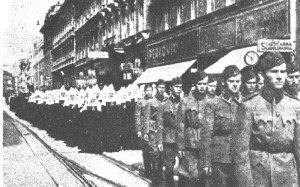Holocaust Education & Archive Research Team |
|
Essays & Editorials Student Essays A brief narrative on the 2006-09 essays by Matthew Feldman 2008 - 2009 2007 - 2008 2006 - 2007 H.E.A.R.T Editorials | |||||||||||
The Holocaust in The Independent State of Croatia: Genocide between Political Religion and Religious Politics
Guest Publication by Matthew Feldman [photos added to enhance the text]
[Please note that editorials posted in this section are the sole viewpoints of the individual author and do not necessarily represent any collective opinion of the Holocaust Education & Archive Research Team, or the University of Northampton]
Duro Schwartz, surviving what he called the ‘inferno’ of Jasenovac through circumstance and vocational utility, composed a detailed memoir about his travails in the Ustaše’s most notorious camp in 1945. After witnessing a catalogue of scarcely believable actions savagely and ritually carried out over his eight months of imprisonment between Autumn 1941 and Spring 1942, Schwartz concluded: ‘If all those who had gone through the camp could join their voices and the despair in their hearts into one voice and one despair, the thunder and horror of the day of judgment would make itself heard’. This chilling account, which could only be written due to Schwartz’s release on account of his marriage to a non-Jewish woman, was still bound to fall short in the eyes of the author, for ‘human language is not powerful enough to even approximate the reality of existence there’.[2] Read more about Jasenovac [here] Despite noting the necessity of trying to speak about an ultimately inexplicable horror – a paradox noted in the accounts of many Holocaust survivors – this did not stop Schwartz from recording, hiding, and later writing up his notes on everyday life at Jasenovac. Another excerpt from his testimonial serves to evoke the brutality of Ustaša guards toward, especially, Jews, Serbs, and Roma and Sinti travellers: To break the monotony an Ustaša walks up to us now and then and hits us with the butt of his rifle [….] Some more naïve prisoners tried to appease the Ustaša “psychologically,” or, as they put it, “in a nice fashion”. Dr. Vlatko Donner, for example, said, “They are human beings, after all! One should always be polite to human beings. Wait and see that he will be polite toward me.” Lo and behold, when an Ustaša came to him and hit him with the butt of his rifle, Donner reproached him with a plaintive voice: “Brother, don’t hit me, can’t you see I am weak and ill?” But the reaction was the opposite of what he expected, as the “brother” landed a blow on his head that stunned and knocked him down. Then the “brother” gave him a few kicks for good measure. This was the harvest of psychology and pedagogy.[3] By appearing silent and invisible, yet at the same time as a skilled builder and team leader, Schwartz survived the arduous winter of 1941/2. During this time, he was put to work expanding the camp infrastructure, identified in Filip Skiljan’s chapter in this volume as two of the five units ultimately comprising Jasenovac; namely, camps III and IV. Yet more than sixty years on, historians have only scratched the surface of the psychology shaping actions by the Ustaša in the wartime Independent State of Croatia; and not least, the challenge to pedagogy for those attempting to explain what happened there between April 1941 and May 1945. What, then, can one say about the Independent State of Croatia? Wading through oftentimes politically-charged scholarship – which, perhaps reflecting Yugoslavia’s tumultuous history, may be anti-clerical, nationalist, Marxist or liberal humanist (let alone their opposites) – underlines the difficulty of comprehensive responses to such a question. In the limited Anglophone texts on the NDH to date, one thread of particularly hostile interpretation has been the former, that is, persisting assertions that the Catholic Church was not only complicit in, but even acted as the principal vehicle for, ‘the development of the Croatian Catholic movement into terroristic clero-fascism’. In this view, Catholicism as a whole bears chief responsibility for ‘the leading role in the ideological preparation and justification for these mass crimes’.[4] Such intemperate criticisms have recently been laid at the archway of the Vatican, and in particular Pope Pius XII, for culpability in the genocide against European Jewry of a variously moral, indirect, and even directly collaborative nature. In more prejudicial renderings, clerics like the short-lived commandant of Jasenovac[5], Miroslav Filipović-Majstorović, were not radical and maverick (and in this case, ultimately defrocked) priests, but were instead representative of long-held anti-Semitism and radically reactionary politics held to be historically intrinsic within the Catholic Church. To be sure, these are serious charges. And even if most accounts fall short of Daniel Jonah Goldhagen’s encore performance in sleight-of-hand history, the claim that the Church was fundamentally compromised by decisions at the top and actions at the bottom remains a persistent one.[6] Yet a closer look suggests that much of this debate is misdirected. In David Dalin’s insightful narrative, this has little to do with World War Two and Holocaust, and rather more to do with ulterior political agendas, from the earlier ‘standard Communist agitprop’ holding that Pius XII harboured Nazi sympathies, to more recent and surprising calumnies by liberal ex-seminarians and Catholic priests like Cornwell, James Carroll and Garry Wills, which ‘are about using the sufferings of Jews fifty years ago to force changes upon the Catholic Church today’. ‘The technique for recent attacks on Pius XII’, Dalin continues, ‘is simple. It requires only that favourable evidence be read in the worst light and treated to the strictest test, while unfavourable evidence is read in the best light and treated to no test.’[7] Another historiographical survey finds the same methodological partiality: Most of the Pope’s critics tend to extremism, while defenders tend toward moderation. This is because the critics have taken the position that the Holocaust would have been much diminished, or even averted, by strong papal action, while defenders of the Pope argue more convincingly that a strong papal protest would have had little effect upon the Nazi machine of destruction.[8] Interesting circumstantial evidence may be found in Bottum and Dalin’s recent The Pius War: Responses to the Critics of Pius XII. In an extensive catalogue of works on the debate over Pius XII, William Doino Jr. provides hundreds of titles under the twin headings “Major Attackers” and “Major Defenders”. The distinction between extremism and moderation in the titles alone is instructive.[9] Such revisionist attacks on wartime Catholicism, however, as Thomas Woods points out, have to contend with (or, indeed, ignore) the fact that ‘Pope Pius XII was deeply admired in his day and in the years following his pontificate’.[10] To Holocaust survivors, members of Pius XII’s inner circle, Jewish leaders, and diplomats on the spot, the Vatican’s interventions on behalf of Jews were frequent, dangerous, and heroic. Here, two points are worth mentioning which seem, to me least, decisive.
The first is the catalogue of material aid delivered to those in need – especially baptised Jews, yet certainly not exclusively Christians – from arranging transit visas and facilitating emigration outside Europe until 1943, to opposing deportations and hiding persecuted Jews thereafter. That more than 3,000 Jews hid in the Pope’s summer residence at Castle Gandolfo alone, and that 80% of Italian Jews survived the Holocaust while 80% of European Jews did not, speaks volumes. Doubtless specific mistakes were made, or opportunities to save lives were shamefully squandered. But the thrust of Vatican policy was just and humane, as was widely recognised at the time. This is because, far from being a Nazi sympathiser, Pius XII, according to Pierre Blet’s judicious study, ‘employed all the means at his disposal to save [Jews]. As much as possible he took care to limit what he said in public, expecting nothing worthwhile to come of this. He did not speak, but he took action.’[11] A second point seems equally decisive, one also obscured in recent revisionist accounts: the Nazis regarded Pius XII as a ‘Jew-loving’ Pope and an implacable enemy of the Third Reich. The Pope knew he had no favour with Hitler and the regime; indeed, even listening to the Vatican Radio (set up by Eugenio Pacelli in 1930) was punishable by death in wartime Germany and Poland. The Vatican’s own views were clear to leading Nazis following the publication of the 1937 encyclical “Mit brennender Sorge” [“With Burning Concern”] – one of a number of attacks on racial doctrine penned by then-Vatican Secretary of State Pacelli – which goes a long way to explaining why the Nazis opposed, rather than celebrated, Pacelli’s ascendance to the papacy in 1939. Thereafter, abortive attempts by the Nazis up to 1944 to kidnap or even kill the Pope for obstructing the Final Solution suggest that, instead of ludicrous claims that he was “Hitler’s Pope”, Pius XII was no friend to the Nazis; quite the opposite. No matter what some commentators may argue today, through sometimes injudicious interpretation; at the time, for example, no one misunderstood the Pope’s Christmas message of December 1942: ‘humanity owes to the hundreds of thousands of people, who, without any fault of their own and sometimes because of their nationality or race alone, have been doomed to death or to progressive extermination’.[12] The SD certainly grasped the point of this address, far better than many later interpreters: ‘He virtually accuses the German people of injustice toward the Jews, and he makes himself the spokesman of the Jews, who are war criminals’.[13] Yet even before Rolf Hochhuth’s notorious hand grenade, the 1963 Der Stellvertreter: Ein christliches Traverspiel [The Deputy: A Christian Tragedy], savaged Pope Pius XII – and by extension, wartime Catholicism as a whole – for “silence” in the face of the Nazis’ Final Solution, such hyperbolic charges had been familiar enough. Despite limited Anglophone works on the NDH then and since, polemics of this type (intended to be less fictional than Hochhuth’s jeremiad) were already circulating in English. To varying degrees, these have largely held the Catholic hierarchy, both in the Vatican and in the Croatian Archbishopric under Alojzije Stepinac, somehow complicit in the Holocaust. An early, representative example, the 1962 Genocide in Satellite Croatia, helps clarify this point. Edmond Paris’ account unswervingly interpreted the NDH as a kind of chameleon coloured by imported Naziism and Rome-led clericalism, justifying charges of collusion between the NDH and the Croatian Catholic clergy – especially Archbishop Stepinac – in forced conversions, torture and mass murder. This led to maximalist evaluations of Catholic complicity in NDH’s genocidal campaign. For instance, his estimated death toll of 200,000 at Jasenovac alone is more than double that estimated by Filip Skiljan here – roughly 80,000 Jews, Serbs, Roma and other “undesirables” – while Paris’ other assertions have shown similar signs of age. In sum, works like this have not helped form a more dispassionate understanding of the Independent State of Croatia.[14] That said, those pivotal themes identified by Edmond Paris and others – ideology, religion and genocide – are also those central to this groundbreaking study.[15] Needless to say, the application of such massive and contentious terms to the Ustaša state is challenging, and this exploration will only attempt to sketch to these by way of drawing heavily upon recent Anglophone scholarship. The chapters comprising The Independent State of Croatia (NDH), 1941-45, have done the most to address these weighty themes through extensive empirical documentation and judicious historical evaluation. Ranging from media and foreign relations in the NDH at the top echelon of decision-making to the militaristic and murderous actions of Ustaša and Home Guard units on the ground, these collected essays in Totalitarian Movements and Political Religions (volume 4, number 2) paint a complex portrait of the NDH nevertheless. For even the title ‘NDH’ [Nezavisna Država Hrvatska] is misleading: indeed, Ramet’s “Introduction” quotes a comment from President Stjepan Mesić to the effect that the Independent State of Croatia, in actuality, ‘was not independent, was not a state, and was not Croatia’. Yet as a relatively marginal outlawed movement until 1941 – one existing on Italian means and without mass-based support, and one only taking power through exceptional events in Nazi-dominated Europe, as Ivo Goldstein makes clear in his “The Independent State of Croatia in 1941: On the Road to Catastrophe” – the Ustaša movement established a quasi-functional regime, existing for some five years with a sizeable degree of autonomy (albeit over progressively diminishing territory). And if the NDH was ‘defined by its subjugation to the power of Germany and Italy’, to use a phrase from Mario Jareb’s “Relations with Italy and Germany” which is echoed by most of contributors, the government was still able to enforce its draconian racial-religious schema for millions of those under its wartime rule. And if Ramet is right to conclude in her edited volume that ‘Ustašism was not a unique phenomenon’, its hydra-headed character, as we shall see, nevertheless also meant the regime was simultaneously sui generis in terms of wartime circumstance, forming ‘the only new fascist state placed directly in power by Hitler with the opportunity to enjoy extensive autonomy and to develop its own system’ as Stanley Payne points out in “The NDH State in Comparative Perspective”.[16]
As a whole, then, Ramet’s collection sheds substantial light upon, but does not simply resolve, the challenges to historical understanding starkly posed by the NDH. Perhaps what Duro Schwartz called the Independent State of Croatia’s ‘harvest of psychology and pedagogy’ cannot, and moreover perhaps should not, simply give way to detached comparative summary or biased politicised explanation. With this in mind, , it is instructive to revisit to three pivotal themes: ideology, religion and genocide. For their heuristic application may, in fact, help to elicit some salient characteristics of the Ustaša movement and regime noted elsewhere, while also demonstrating the difficulties of overarching explanation facing the study of wartime Croatia. Such a Janus-faced reading will therefore aim to both delimit some conceptual features bearing upon the murderous interplay of religion and politics in the NDH, and concede that the Ustaše’s ‘psychology and pedagogy’ may not allow for any straightforward accounting for it – let alone any inflexible or essentialist one. In short, one may be able to tally up the figures and cite the reasons, but the crimes committed in wartime Croatia must, surely, baffle all attempts at humanistic understanding. For my part at least, this is the only way I can approach statements linking these three themes so starkly, like the following, made by a priest and cabinet minister, Dionizije Juričev, in his role as Head of State Direction for Renewal on 22 October 1941: In this country only Croats may live from now on, because it is a Croatian country. We know precisely what we will do with the people who do not convert. I have purged the whole surrounding area, from babies to seniors. If it is necessary, I will do that here, too, because today it is not a sin to kill even a seven-year-old child, if it is standing in the way of our Ustaša movement […] Do not believe that I could not take a machine gun in hand just because I wear priests vestments. If it is necessary, I will eradicate everyone who is against the Ustaša state and its rule - right down to babies![17] Ustašism: ‘the catastrophe of our Independent State of Croatia had a moral cause’ The above heading, quoted from a postwar article by the regicidal Ustaša functionary Eugen Dido Kvaternik,[18] provides a starting point for discussion of Ustaša ideology; even more so when placed next to Juricev’s earlier proclamation. For Kvaternik was, the ‘planner and organiser of genocide’ and was regarded at the time as the ‘“symbol of Ustaše terror in the NDH’” in Ivo Goldstein’s assessment here, supporting this view with a quotation on Kvaternk as a destabilising threat viewed by German Plenipotentiary Edmund Glaise von Horstenau, who viewed him as ‘the most hated man in the land’. Indeed, Kvaternik hangs like a vulture over Juricev’s decree. Yet if the former’s ‘moral cause’ can be maintained in the face of a declared willingness to execute children, “morality” must be understood – not in Kvaternik’s exculpatory terms of “goodness” or some sort of backdoor justification – in the definitional sense of the word as ‘a system of values and moral principles’; whereby the latter concern ‘the distinction between right and wrong and good or bad behaviour’ (Compact Oxford English Dictionary). If one is willing to grant fascist ideology the possibility of such a ‘morality’, that is, if fascist movements can be understood in their own terms containing a system of values helping to shape behaviour, then one may technically accept the accuracy of Kvaternik’s comment while emphatically rejecting the mindset guiding it, either before or after 1945. This, in turn, begs the question of what values a fascist like Dido Kvaternik might hold. By way of response, it is worth cautioning that Fascist Studies is an contentious area, even if Roger Griffin perceived a ‘new consensus’ emerging in the field toward the end of the 1990s. While this is not the place to rehearse this important debate about the generic nature of fascist ideology, suffice it to say that many more researchers are now willing to grant fascism status as a political ideology of hyper-nationalistic inclination, with both “positive” (e.g. being “for” something; as with Griffin’s use of the term palingenesis) and “negative” values (being “against” something; such as anti-Semitic scapegoating and demonisation) in movements across interwar Europe – and likely beyond, both in terms of geography and period.[19] In what follows, fascism will therefore be understood as a specifically modern form of secular “millenarianism” constructed culturally and politically, not religiously, as a revolutionary movement centring upon the “renaissance” of a given people (whether perceived nationally, ethnically, culturally, or religiously) through the total reordering of all “healthy” collective energies towards a realisable utopia; an ideology implacably hostile to democratic representation and socialist materialism, equality and individualism, in addition to any specific enemies perceived as alien or oppositional to these secular myths. In practice, however, many scholars have long omitted the Croatian Ustaše as well as the NDH regime from comparative discussions of fascism, seeing these as alternatively ‘semi-fascist’ (Hory and Broszat)[20] ‘proto-fascist’ (Griffin);[21] or more typically than these two examples, simply omitting the movement from taxonomic considerations altogether. Those confronting the problem have often perceived too much emphasis on Catholicism to make Ustašism a genuinely secular political ideology (instead acting as a form of “clerical fascism”, of which more presently), or instead, have found that the lack of any Croatian “nation” as such (unlike Western and Central European states) – in terms of complete political sovereignty over Croatian territory – ipso facto denies the Ustaša status as a nationalistic movement – and hence as containing anything other than an idiosyncratic, localised political credo. It is precisely this milieu – particularly the interplay of religion and nationalism in interwar Croatia – that has offered a consistent challenge to interpreters of comparative fascism in respect of both the Ustaša movement and NDH regime.
Before considering the Ustaša movement in terms of a fascist movement – and consequently, a political religion – along the interpretative lines indicated above, a few contentious points ought to be highlighted. First of all, “nationalism” is a notoriously tricky topic, possibly even more difficult to characterise than “religion”. Nonetheless, one can advance some assertions regarding the Croatian case. Most importantly, the fact that there had been no sovereign Croat state since 1102 in no way precludes Croatian nationalism. In fact, the classical liberal ideal espoused by Starčević in the nineteenth century was not far different than that of contemporaneous European nationalists like Garibaldi. That the latter succeeded in creating a territorially-defined state rather from a national ideal while his Croatian counterpart did not, moreover, may have actually served to augment Croatian nationalism throughout the succession of crises and conflicts plaguing interwar Yugoslavia. This reading of nationalism is certainly in keeping with major theories on this particular badge of identity as a distinct, modern (initially European) phenomenon with ‘a comprehensive doctrine which leads to a distinctive style of politics’. Amongst other points of direct relevance to Ustaša nationalism, Elie Kedourie continues: ‘Nationalists make use of the past in order to subvert the present’. Finally, in this nationalist doctrine, language, race, culture, and sometimes even religion, constitute different aspects of the same primordial entity, the nation [….] What is beyond doubt is that the doctrine divides humanity into separate and distinct nations, claims that such nations must constitute sovereign states, and asserts that the members of a nation reach freedom and fulfilment by cultivating the peculiar identity of their own nation and by sinking their own persons in the greater whole of the nation.[22] As such, the Croatian people’s own historical narratives, linguistic and ethnic ties; and most importantly, perceived sense of its own collective community and distinctive, providential history, locates a majority of Croats as nationalistic within Yugoslavia on the eve of World War Two. And while the distinction between generic nationalism and fascism’s hyper-nationalism (or ultra-nationalism) is similarly challenging, the difference in rhetoric separating the Croat Party of Right/Ustaša from the Croat Peasant Party [HSS] and Populists [HPS] is not. The chasm is unmistakeable: the former is unabashedly revolutionary whilst the latter two are essentially conservative. For there remained a clear division between Croatian rejectionists and reformists, that is, between those willing to work within the federal structure of Yugoslavia, and those who, like the Ustaša, were bent upon its destruction – a distinction placed in sharp relief by the autonomy brought about by the August 1939 Sporazum. In the context of fractious Croatian and Yugoslav politics up to 1941, then, it seems safe to equate what Biondich calls the sizeable ‘hard opposition’ of Croatian nationalists with an ultra-nationalism indispensable to interwar fascist ideology. At the same time, however, this is not to say that all Croatian ultra-nationalists necessarily became supporters of the NDH. Moreover, the invocation of state religion is characteristic of all nationalist movements. That the Ustaša drew heavily upon Catholicism as a form of community identity in no way compromises its fascist bona fides (as a glance at the appropriation of Christianity by the Romanian Iron Guard, the Spanish Falange, or the Afrikaaner Ossewabrandwag demonstrates). Here, it is a question of first principles. If interwar fascist ideology was focussed upon the mythic “nation”, its self-selective criteria for community inclusion – both racial and religious under the later NDH regime – must always vary from location to location. Just as German culture emphasised a technocratic scientism of race as the defining feature of its (religiously divided) ‘Aryan’ Volksgemeinschaft, so the Ustaša emphasised centuries as a Catholic “bulwark” in the east as an identifying characteristic of the Croats’ own championed Volksgemeinschaft. (Of course, this does not mean that eugenic thinking and the like was absent from either Croatian intellectuals or Ustašism.[23]) Like all fascist movements enjoying power, the NDH ‘tried to portray itself as an organic part of Croatian culture and history’, amongst which, Ramet argues in The Three Yugoslavias, meant appropriating existing Croatian Catholicism toward secular political ends. By placing Catholicism within the cosmology of the (ultimately abortive) totalitarian state, the NDH doubtless wanted people to worship in a Ustaša style no less than the party programme of June 1941 asserted that in ‘“the Ustaša state, created by the poglavnik and his Ustaše, people must think like Ustaše, speak like Ustaše and – most important of all – act like Ustaše. In a word, the entire life in the NDH must be Ustaša-based”’.[24] Yet this was a secular, not a religious, regime, one that appealed to (and ultimately perverted) centuries-long Croatian traditions of Roman Catholicism to initially legitimate its rule. How else can one interpret propaganda spouted by Hrvatski Narod [The Croatian People] that seamlessly equated Catholicism, “Croatianness” and the Ustaša? Thus in terms of causality, for Croatian fascists, placing the state before God – like the 300 or more Ustaša ultra-nationalists exiled with Ante Pavelić in Italy, later to become the central apparachiks of the regime between 1941 and 1945[25] – religion was but a constituent part of a Greater Croatian “nation” always intended to be (re-)created and “purified” through widespread violence. Now, a host of other features also show that Ustašism contained problematic characteristics when compared to rival fascist movements in practice. Foremost here, Pavelić did not fit the classic fascist mould as a charismatic leader, despite his 1933 adoption of the title Poglavnik and penning the movement’s ideological tract, Principles of the Ustaša Movement.[26] Whatever else he was, Pavelić was not an accomplished demagogue like Hitler or Mussolini. Nor was his pragmatic swap of Italian support and diplomatic recognition, a main feature of discussion in Mario Jareb’s “The NDH’s Relations with Germany and Italy”, for the overwhelmingly Croatian Dalmatia – enacted through the Rome Pact on 18 May 1941, but actually pledged by Pavelić as early as June 1927 – perceived to be a deal any “genuine” ultra-nationalist would undertake.[27] Yet if the NDH was indeed a fascist state, and a defining feature of fascist states is expansionistic power politics as the outward expression of national rebirth, it is salutary to note that this does extend to a total unwillingness to compromise. Both the Nazis and Fascists fully realised this factor when accommodating other elite (largely conservative) groups once in power. For its part, the Independent State of Croatia was simultaneously willing to negotiate out of political necessity (one may even include the 1942 enforced creation of the Serbian Orthodox Church as an example here), while showing no mercy to those ideological outcasts within its grip. The point is, conflating the practical policies of a fascist state with its idealised worldview risks mistaking an ideological core with its specific political manifestations, or in Michael Freeden’s terminology, ‘adjacencies’.[28] Keeping the two separate becomes all the more important in the case of the NDH, not least because of the speed in which political events initially transpired in the revolutionary days of spring 1941.
In terms of ideology, it is here that the theory of political religion may be of substantial interpretative use. In brief, this approach, given currency within political science by Eric Voegelin (and, to a lesser extent, Raymond Aron, building upon Weber, Durkheim, Eliade and others), but now associated especially with Emilio Gentile and Hans Maier, holds that the human sense of the sacred is often temporally manifested through phenomenological behaviour that need not be directed toward the supernatural, or the divine. Marxist-Leninism, of course, directs faith-based actions at the proletariat, while it was with the nation or race that fascist ideology insisted on investing with a sense of the numinous; yet both ideological systems and their attendant political permutations in the twentieth century are, in this reading, ultimately intelligible as secular forms of devotion. Thus, as the ‘tremendum et fascinosum’ of religious experience dissipates in the face of a modernising Europe’s charging horsemen of the apocalypse – anomie, secularisation, consumerism and sweeping technological change, to name but four – the ideology of the state or Volk becomes the new hymn-sheet for the rechristened masses under fascist regimes. The nation therefore becomes both the main icon and cathedral for collective worship. So long as one can separate the “‘technical” aspects of the bid for and assertion of power’ (such as political compromise or organisational structure) from their ideological underpinnings, Hans Maier emphatically argues that political religions helps to explore the latter, for this theory ‘directly addresses the logic justifying modern despotisms and, with the help of categories from sociology and the psychology of religion, can help us understand it better’.[29] While the features of political religion are more evident in relation to (even dysfunctional) totalitarian states with a period of peacetime consolidation like Nazi Germany and Fascist Italy, the NDH had neither the time nor organisational strength to “convert” a citizenry quickly sliding into civil war against Chetniks and Partisans – a populace more concerned with daily bread by summer 1941 than a deified nation. This is quite distinct from finding that the Ustaša never even tried to instil a functional political religion into the Independent State of Croatia. By way of brief example, the linguistic subject (and object of worship) in Slavko Kvaternik’s infamous proclamation of independence on 10 April 1941, despite its first word, is not God, but the sacralised nation: ‘God’s providence and the will of our ally, as well as the hard centuries-long struggle of the Croatian people and the great efforts of our Poglavnik Dr Ante Pavelić and the Ustasha movement both at home and abroad, have determined that today, the day before Easter, our independent Croatian state arise’.[30] Christ’s celebrated resurrection during Easter was but the occasion for an even holier, more numinous resurrection: that of the Croatian nation. The difference is fundamental.
For the NDH, not the Catholic orders, oversaw forced conversions; it was Ustaša ideology behind the influx of racial – not religious – anti-Semitism in 1941; and it was the latter’s secular ideology that was the driving impetus in the NDH’s sanguinary pogroms. By way of example, an avalanche of laws ensuring the “purity” of Croatia from April 1941 (language, culture, race, morality and so on) was largely undertaken against Church opposition. All this points to Ustašism as not a politicised religion, but a political religion — a sacralised form of secular politics, and hence a travestied form of Christianity (albeit one aided and abetted by a genuine faction of “clerical fascists”, which we shall consider presently). Both the fascist ideology long held by Pavelić and his exiled clique, as well as their practical decision-making that knowingly increased the Church’s marginalisation between 1941 and 1945, should not leave in doubt the ultimately secular character of the regime – one brandishing Catholicism like a murderer wields a loaded gun. “Christianism”, or ‘priests in whose hands revolvers might better be placed than a crucifix’[31] Much has been written of late about Islamic fundamentalism as a radical variant, perhaps bastardisation, of the Muslim faith, especially since the horrific terrorist bombings of 11 September 2001. Scholars working in this area of political science – calling themselves “Islamicists” – have settled on “Islamism” (rather than “Islamo-fascism”, Islamic fundamentalism, or “jihadism”) as the preferred term to describe these extremist, frequently violent movements – groups usually traced back, both ideologically and organisationally, to Islamic ideologues like Sayyid Qutb and Hassan al-Banna.[32] It seems clear that such groups may be profitably categorised within the genus religious politics rather than political religion. As has been suggested, religious politics, in diametrical contrast to political religions, politicises an existing faith, meaning that their raison d’être, the core of this worldview, is an earthly-manifested belief in a sacred (supernatural) rather than secular (ideological) cause. But one may ask whether the capacity for organised religion’s radical politicisation is limited to the Muslim faith, to the postwar world, let alone simply to “terrorists”. Those in glass houses ought to be more wary of casting stones: if Islamism may be dispassionately and objectively explored as a radical form of religious politics, might not the same be said about an historic and/or existing “Christianism”?
Compelling evidence has long suggested that Christianity is no more inured to extremist applications of the faith than Islam, with groups no less revolutionary continuing to crusade under a Christian banner in places like, for a recent example, the United States.[33] And, parallel to the creation of Islamism by the Muslim Brotherhood in 1928, a radical form of Christian religious politics arose in the interwar period. Across Europe in the 1920s and 1930s, a cross-section of Orthodox, Protestant and Catholic clerics – and occasionally their religious organisations – gave material support to radical right and fascist movements. While comparative research on this phenomenon is in its infancy, a few claims made be made, however tenuously, bearing directly upon the case of the NDH. Like elsewhere in Europe, in the new Yugoslav kingdom political Catholicism and its lay institutions (most notably Catholic Action) were of recent vintage. These movements came to prominence, in no small measure, as a proactive response to many of the same perceived decadences of modern life that fascism likewise arose to combat in the wake of World War One: Marxism and materialism, liberalism and individualism, capitalism and cosmopolitanism. This amorphous movement may be regarded as fellow-travellers of fascism, with an important article of faith separating their paths: the Christian God (in an extensively elaborated and ‘revised’ version) came first for clerics intervening in politics where, for fascists, the nation became a partially-revealed, ersatz god. No hard and fast distinction as yet exists in the realms of experimental psychology to show how one “chooses” a particular worldview as a formative organising principle, but this is arguably the key distinction between political religions – frequently keen to appropriate a particular community’s religious tradition as an indicator of its unique cultural identity and nationhood – and religious politics. The former translate into pseudo-religious categories a secular entity (class, race, nation, and so on). The latter are fundamentally religious interventions into politics. Notwithstanding the terms’ semantic similarities, the ideological difference remains immense in works devoted to the study of political religions (e.g. Maoism, Stalinism, Fascism and Nazism). For distinct (indeed, incommensurate) basic mindsets are at work; even if members and their “Christianist” allies in Croatia butchered Serbs side by side, the latter did this out of a wholly misguided application of Catholicism to the moral justification of racial hatred, while for the former, Catholic morality in toto was only useful insofar as it helped realise the utopian state sacralised and deified by an ultimately secular Ustašism. This summary, perhaps, offers an interpretive brush with which to paint Catholic actions during World War Two, capable of distinguishing between secular and religious extremism rather than simply conflating the two. Yet it does not simply exonerate the Catholic Church from all actions taken by men of the cloth within the NDH. Still, holding individual members of the Catholic clergy accountable for decisions taken in wartime Croatia (or rather failed to take) is an altogether different proposition from holding Catholicism accountable tout court for crimes in the NDH they did not foresee (although, given the Ustaša’s pre-existing credentials for murder, perhaps they should have). Clearly scores of Catholics, within and outside the Church alike, behaved devilishly. But there were also scores of Catholic priests and even more lay Catholics who joined the Partisans in order to fight fascism. That the hierarchs of the Catholic Church in Croatia made a Faustian bargain for long-awaited political sovereignty in 1941 does not itself make its priests, laity or institutions, of necessity, devils. It does, however, raise a final question: What actual proportion of this Catholic congregation may be considered “clerical fascist”, or more confessionally specific, “Christianist”? In the first place, “clerical fascism” may well be an oxymoron when applied beyond clerics, theologians or lay organisations (none of which was enthusiastically embraced by the various fascist movements during the interwar period). In the first comprehensive academic investigation of the collusion between fascist politics and radicalised Christianity in interwar Europe to date, Clerical Fascism in Interwar Europe, Croatia’s swirling currents of religious politics and political religion emerge as far from unique. The precise relationship between the two becomes more comprehensible when placed in its international context, and when it is explored heuristically within the context of Griffin’s definition of “clerical fascism”: The ideology and political praxis of clerics and theologians who either tactically support fascism as a movement or regime while maintaining a critical distance from its totalising, revolutionary, and basically secular objectives, or integrate elements of fascist values and policies into the way they conceptualise their mission on earth as devout believers in a divinely ordained world. As such, clerical fascism can never be a movement in its own right with a clerical leadership, independent ideology, and autonomous organisational structure, though it may operate as a discrete faction or constituency within a fascism regime with which it enters a symbiotic relationship.[34] Wartime Croatia abounded with examples of both tactical support and symbiosis. A second feature of this volume, ‘Clerical Fascism’ in Interwar Europe (which first appeared as a Special Issue of Totalitarian Movements and Political Religions), suggests that a certain demographic pattern may also be discernable in terms of clerical adherents to national fascist movements.
Mark Biondich’s contribution on the Croat clergy notes that ‘the younger generation of radical Catholics, particularly those of the crusader organisation, supported the Ustaša regime with considerable enthusiasm, while the older generation of Croat Populists [HSS] was more reserved and in some cases overtly hostile’.[35] In support of this subsequent assessment, Biondich here cites Augustin Juretić’s report on the Zagreb Archbishopric of June 1942, which found that ‘“the younger clergy raised in the so-called Crusader organisations is, with few exceptions, completely Ustaša. The majority does not condone the killings – one small part has in general lost all sensum moralem”’. To be sure, this demography saw radical, especially younger, clerics of all major Christian confessions swept into to the ambit of individual fascist movements throughout Europe. In Croatia, the generational gap between conservative and radical Catholic priests in the nearly thousand strong Zagreb Archdiocese was also divided by region (and particularly urban centres); order (e.g., Fransciscans were more prominently associated with the Ustaša than were, say, the Salesians); geographical location of churches and bishoprics; a given priest’s place within the Church hierarchy (with more senior clerics generally disassociating themselves from the NDH); and of course, a wide range of personal experiences and values. Despite the fact that Croatian Catholicism ‘was a heterogeneous and politically divided movement’, the drift of Yugoslav politics increasingly led Catholics in Croatia – lay and clergy alike – toward a wholesale rejection of their fractious interwar state; in practice, Biondich finds, this means ‘the Catholic movement largely committed itself to Croatian statehood’ – a movement itself strongly conditioned by conditions in interwar Yugoslavia – and by ‘the interwar nationalism and growing radicalism of the Catholic movement in Croatia’.[36] Patient reform of Yugoslav federal structures therefore gave way to the siren-call of some form of politico-spiritual revolution amongst the Croatian clergy – ends, if not means to those ends, shared by the outlawed Ustaša movement. As the 1930s Royal Dictatorship wore on, the politicisation of Catholicism in Croatia was, without doubt, increasingly tied to Croatian state sovereignty. With the choice between supporting a paralysed Yugoslav federation and an idealised Independent State of Croatia, the clergy, from Stepinac on down, placed themselves on the side of Croatian sovereignty – and thereby Ustaša rule – in April 1941. It appears to have been an informal, collective decision made at a critical period, one that found the Catholic movement’s religious politics seemingly overlapping in a favourable way with the Ustašism. That the slaughter unleashed by the NDH caused most of these clerics to rethink this support as early as the summer of 1941 is a vital point to remember before one judges their naïve expectations of Croatian statehood. But the early endorsement of the Independent State of Croatia – in the interests of crowning the new state at a time when the Croatian clergy, let alone their flock, were caught between rival factions – was a decision held against Catholicism ever since 1941. Indeed, this was a persisting problem throughout the war, as Marcus Tanner’s study of Croatia maintains: ‘The [Catholic] right wing and the clericals were held back from opposing the NDH by their conviction that Croatian independence was a good thing, even if the form that it took under Pavelić was not.’ This view stands in stark contrast to the unworkably neat division between religion and nation offered by Jelinek in 1980: ‘One may go as far as to say that certain Croat priests became “schizophrenic” when national and religious demands called for split loyalties; and in nationalistic zeal often breached the Ten Commandments’.[37] For the Catholic Church in Croatia, in the final analysis, the fallout was considerable: more than 200 priests joined the Ustaše ranks, blessing flags and battle units, taking part in Ustaša funerals and holding ritual masses; of these, fully 124 were decorated with Ustaša medals for their service to the NDH.[38] Whereas religious politics, in a banal sense at least, may be observed wherever clerics become directly involved in politics, the term “Christianism” is intended to denote a more radical, revolutionary approach to secular politics (right- or left-wing – think here of Marxist-inspired “Liberation Theology” in 1980s Latin America), one nonetheless also arising from the Judeo-Christian tradition. The thread connecting the two is, without doubt, a long one, stretching from familiar expressions of religious politics at one end of the spectrum – such as a clerical blessing at a political ceremony or event – to extremist manifestations on the other; like, say, the German Christians [Deutsch Kristen] of the 1930s, or The World Church of the Creator today – both prime examples of radical right “clerical fascism”. And along the axis of religious politics there are many stopping-off points, with Stepinac and most within the Catholic hierarchy in Croatia taking a politically reformist stance to the NDH; certainly not a “Christianist” one. But this does not mean that wartime Croatia, was without its share of “Christianists”, and more specifically, “clerical fascists”. This designation not only demarcates those who personally committed violent acts against the innocent, but those who knowingly put their religious faith at the disposal of a genocidal state whose aims were clear within several months of taking power. Critically, this view is based on the political fusion, or hybridisation (not simply intellectual schizophrenia, or religious “bad faith”), of Catholicism and “Croatianness”’ by clerics like Archbishop Ivan Šarić of Vrhbosna. And if for these “Christianists”, as opposed to secular-minded fascists worshipping the Croatian state via Ustašism, Catholicism’s God remained the source of their own first principles, these were truly savaged and perverted. For the right-wing “Christianists” serving the Independent State of Croatia took Catholicism and transmuted it into a chauvinist, racist, and murderous doctrine, one antithetical to the Jewish Ten Commandments and Christian Beatitudes alike. By way of illustrating the religious zeal within which such “clerical fascists” swaddled their infant state, consider the song for Chirstmas 1941 by a leading “clerical fascist” and devotee of the NDH, Šarić, entitled “Dedicated to the Poglavnik”:
Conclusion: ‘the satanic side of man and the injustice reigning in all of nature’ Of all the circumstances plaguing interwar Yugoslavia and wartime Croatia, the interplay of Ustaša political religion and “Christianist” religious politics may be the most noxious. And elusive. And destructive. Although this was a marriage of convenience, sharing many common enemies and, above all, an overarching desire for political sovereignty, religion and nation were not the inseparable couple in Croatia that they have sometimes been made out to be. The interplay was more complex, and less susceptible to neat historiographical analysis. For both radical Catholicism and Ustašism had their own, only partially intertwined, histories. Once pulled apart, these histories are subsumed within comparative studies of fascist political religion and of “clerical fascist” religious politics, respectively. In turn, both belong to the integrated history of modern Europe, not just the abortive and disastrous Independent State of Croatia. In a recent work on the latter subject Jozo Tomasevich concluded, the ‘Ustaše and their Clericalist allies who constantly stressed that Croatia belongs to the Western world because of its religion, culture, and tradition practiced a politics and ideology that were the antithesis of Western ideals’.[40]
These final words offer a comforting thought, but it should not be forgotten that rationally-constructed extermination camps, scientistic racism, as well as secular and divine millenarianism are also, and have long been, integral components of Western modernity, no matter how reluctant historians who uphold the ideals of Enlightenment or Christian humanism are to acknowledge it. That the Ustaša movement turned its back on the latter ideals and resolutely pursued its own bloody path to an alternative modernity through the former set of ‘values’ remains a distasteful subject to consider, but one that must be faced by historians without resorting to crude stereotypes, generalisations, or assumptions about a Croatian Sonderweg. The resulting scholarship may not only reveal further insights into the nature of the NDH, but also about the capacity for genocidal excess by “faith-based” protagonists of a new order that would resolve the chaos of early twentieth-century history. Certainly the dehumanising trajectory of Ustaša barbarism needs to be examined in its own right, through important archival studies like those presented here – employing, where appropriate, heuristic tools like political religion and fascist ideology from a secular perspective, and “Christianism” and “clerical fascism” from a religious one. In tandem with this, the NDH’s place within a broader European ‘politics and ideology’ needs to be explored more thoroughly, in order to illuminate both the specific case of the NDH, as well as the panoramic vistas afforded by the comparative study of religion, ideology and genocide in wartime Croatia. Yet, in doing so the importance of empirical reconstruction and theoretical explanation ought never obscure the fate of millions of innocent civilians, like Duro Schwartz, condemned to experience this manmade apocalypse “on the skin”: Just as in our existence as slave prisoners in this inferno the camp was a world diametrically opposite to the rest of the world, so the people, former prisoners, who had experienced in the depths of their being and on their flesh the satanic side of man and the injustice reigning in all of nature, forever ceased to resemble human beings, equal to the rest of humanity.[41]
ENDNOTES [1] I would like to thank Paul Jackson, Marius Turda, Kathy Orange, and Roger Griffin for their discussions toward this article, and in particular, Sabrina Ramet for her friendly patience and insight over earlier drafts of this paper. I am also grateful to the Rothermere American Institute, University of Oxford, for a Fellowship facilitating the writing of this conclusion. [2] Duro Schwartz, “The Jasenovac Death Camps”, in Aharon Weiss (ed.), Yad Vashem Studies, XXV (Jerusalem: Daf Noy Press, 1996), pp. 430, 384. For discussion of the difficulty of representing the Holocaust, see Saul Friedlander, (ed.), Probing the Limits of Representation: Nazism and the Final Solution (Cambridge, Mass: Harvard University Press, 1992). [3] Schwartz, “The Jasenovac Death Camps”, p. 386. [4] The preceding two quotations are taken from Vladimir Dedijer, The Yugoslav Auschwitz and the Vatican (Buffalo: Prometheus Books, 1992), pp. 41, 73. [5] Jasenovac is, of course, the camp alluded to in ibid. [6] Daniel Jonah Goldhagen, A Moral Reckoning: The Role of the Catholic Church in the Holocaust it’s Unfulfilled Duty of Repair (Boston: Little, Brown, 2002). See also John Cornwell, Hitler’s Pope: The Secret History of Pius XII (London: Penguin, 2000) for another highly problematic book that takes much the perspective as its provocative title. For a devastating critique of Cornwall’s thesis and methodology, see Ronald Rychlak, Hitler, The War, and The Pope, (Huntingdon: Our Sunday Visitor, 2000), especially his “Epilogue”. [7] See David Dalin, “Pius XII and the Jews”, The Weekly Standard, vol. 6, no. 23, 26 February 2001, online at: http://www.columbia.edu/cu/augustine/arch/dalin.html. [8] José Mariano Sánchez, Pius XII and the Holocaust: Understanding the Controversy (Washington, D.C.: Catholic University of America Press, 2002), p. 177. [9] Doino Jr., William, “An Annotated Bibliography of Works on Pius XII, the Second World War, and the Holocaust”, in Joseph Bottum and David G. Dalin (eds.), The Pius War: Responses to Critics of Pius XII (Lanham: Lexington Books, 2004); see especially Parts Four and Five, pp. 158-211. [10] See Thomas Woods, review of David Dalin’s The Myth of Hitler’s Pope: “How Pope Pius XII Rescued Jews from the Nazis”, online at: [11] See Pierre Blet, Pius XII and the Second World War: According to the Archives of the Vatican, trans. Lawrence J. Johnson (Hereford: Gracewing, 1999), pp.139-81; quoted p. 167. [12] Ibid., p. 161. [13] Ibid. [14] Edmond Paris, Genocide in Satellite Croatia, 1941-1945 (Chicago: Institute for Balkan Affairs, 1962). [15] The anonymously edited The Third Reich and Yugoslavia (Belgrade: Institute for Contemporary History, 1977) contains essays in several different languages. By contrast, this volume, first appearing in Totalitarian Movements and Political Religions, Sabrina Ramet (ed.), “The Independent State of Croatia, 1941-45”, vol. 7 no. 4 (2006), was comprised solely English-language articles (those articles initially published in TMPR were by Sabrina Ramet, Stanley Payne, Ivo Goldstein, Mark Biondich, Mario Jareb and Nada Kisić Kolanović). [16] Sabrina Ramet, (ed.), ‘The Independent State of Croatia, 1941-45’, in Totalitarian Movements and Political Religions, vol. 7, no. 2 (2006), passim. [17] Quoted in Dedijer, The Yugoslav Auschwitz, p. 317. [18] See Jozo Tomasevich, War and Revolution in Yugoslavia 1941-1945: Occupation and Collaboration (Stanford, Calif.: Stanford University Press, 2001), p. 781. Relevant too is an earlier volume by the same author, dealing almost exclusively with the Greater Serbian movement of Chetniks: War and Revolution in Yugoslavia 1941-1945: The Chetniks (Stanford, Calif.: Stanford University Press, 1975). [19] Roger Griffin (ed.), International Fascism: Theories, Causes and the New Consensus (London, Arnold: 1998). For shorter, pivotal extracts of scholarly interpretations of fascism, also see Artistotle Kallis’ edited The Fascist Reader (London: Routledge, 2003); for longer analyses of fascism, consult Roger Griffin with Matthew Feldman (eds.), Fascism: Critical Concepts, 5 vols. (London: Routledge, 2004). [20] cf. Bela Vargo, “Fascism in Eastern Europe”: ‘The authors of a detailed scholarly work about the Croatian State – Andreas Hory and Martin Broszat – suggest the term pre-fascist or semi-fascist for the movement. And in [Ernst] Nolte’s view there is no certainty whatsoever that the Ustasha movement actually qualifies as fascist at all’; cited in Walter Laqueur (ed.), Fascism: A Reader’s Guide (Berkeley & Los Angeles, Calif.: University of California Press, 1976), p. 248. [21] See Roger Griffin, The Nature of Fascism (London: Routledge, 1993), p. 120, although he has since moderated his views on this point: see CONTACT _Con-3D4442651 \c \s \l Matthew Feldman, ed., ‘Fascism’s Century’: Essays on Fascism by Roger Griffin (Basingstoke, Palgrave: 2008). [22] Elie Kedourie, “Nationalism and Self-Determination”, cited in Anthony Smith (ed.), Nationalism (Oxford: Oxford University Press, 1994), quoted pp. 49-51. [23] Currents of eugenics and racial anthropology in Croatia also no doubt contributed to the construction of the ‘new Croatian man’, which Rory Yeomans effectively documents in “Of ‘Yugoslav Barbarians’ and Croatian Gentlemen Scholars: Nationalist Ideology and Racial Anthropology in Interwar Yugoslavia”, in Marius Turda and Paul Weindling (eds.), Blood and Homeland: Eugenics and Racial Nationalism in Central and Southeastern Europe, 1900-1940 (Budapest: Central European Press, 2006), pp. 83-122, especially pp. 102-16. [24] Cited in Ivo Goldstein, Croatia: A History (London: Hurst and Company, 1999), p. 135. [25] See ibid., which further notes that “Pavelić was welcomed by about 2,000 ‘sworn’ Ustaše who had been working underground in the country”, followed by some “100,000 members who had sworn the Ustasha oath” by May 1941, pp. 133-4. [26] See Ivo Goldstein, “Ante Pavelić, Charisma and National Mission in Wartime Croatia”, in António Costa Pinto, Roger Eatwell, and Stein Ugelvik Larsen (eds.), “Charisma and Fascism in Interwar Europe”, Totalitarian Movements and Political Religions, vol. 7, no. 2 (2006), pp. 225-34. [27] See Tomasevich, Revolution and Occupation, p. 30. [28] For the distinction between ‘core’ and ‘adjacent’ ideological manifestations, see Michael Freeden, “Political Concepts and Ideological Morphology”, Journal of Political Philosophy, vol. 2, no. 2 (1994), pp. 140–64. [29] Hans Maier “Concepts for the comparison of dictatorships”, in Hans Maier (ed.), Totalitarianism and Political Religions, vol. 1 (Abingdon: Routledge, 2004), quoted pp. 205, 209 (my emphasis). For further discussion of political religion theory in relation to fascist ideology, see Maier’s three volumes of Totalitarianism and Political Religions (Abingdon: Routledge, 2005/8) and Emilio Gentile’s, recent Politics as Religion, trans. George Staunton (Princeton, N.J. & Oxford: Princeton University Press, 2006). [30] See Tomasevich, Revolution and Occupation, p. 53. The similar message, but with an explicitly different object of veneration, is striking in comparison with the opening of Stepinac’s pastoral letter from 28 April 1941: “There is no one among you who in recent times has not been witness to the important events in the life of the Croatian people, in which we as messengers of Christ’s gospel have been active [….] And who can chastise us when we as spiritual leaders contribute our part to the joy and the enthusiasm of the people, when we full of deep emotion and warm gratitude turn to the divine majesty”, cited in Dedijer, The Yugoslav Auschwitz, p. 95. [31] Dr Franjo Butorac, Bishop of Koto, letter to Stepinac of 4 Nov. 1941, cited in Herbert Butler, “The Artukovitch File”, in R. F. Foster (ed.), The sub-prefect should have held his tongue, and other essays (London: Allen Lane, 1990), p. 289. [32] For a valuable summary of the development of Islamism, as well as details about Sayyid Qutb, Hassan al-Banna, and the founding of the Muslim Brotherhood, see Sayed Khatab, The Power of Sovereignty: The Political and Ideological Philosophy of Sayyid Qutb (London: Routledge, 2006); and Richard Paul Mitchell, The Society of the Muslim Brothers (Oxford: Oxford University Press, 1993). [33] For an insightful account of religious politics in America, see Chip Berlet and Matthew Lyons, Right-Wing Populism in America: Too Close for Comfort (New York: Guilford Press, 2000). For another recent, insightful – and in this case, Christian – perspective on religious politics in contemporary America, see Charles Marsh, Wayward Christian Soldiers (Oxford: Oxford University Press, 2007), especially pp. 1-20. [34] Roger Griffin, “‘The ‘Holy Storm’: ‘Clerical Fascism’ through the Lens of Modernism”, in Matthew Feldman and Marius Turda, with Tudor Georgescu (eds.), ‘Clerical Fascism’ in Interwar Europe (Abingdon: Routledge, 2008), p. 5. [35] Mark Biondich, “Radical Catholicism and Fascism in Croatia, 1918-1945”, in Matthew Feldman and Marius Turda (eds.), “‘Clerical’ Fascism in Interwar Europe”, Totalitarian Movements and Political Religions, vol. 8, no. 2 (2007), p. 393. [36] Ibid., pp. 387, 393. [37] See Marcus Tanner, Croatia: A Nation Forged in War (New Haven, Conn. & London: Yale University Press, 2001), p.156; and Yeshayahu Jelinek, “Clergy and Fascism: The Hlinka Party in Slovakia and the Croatian Ustasha Movement”, in Stein Ugelvik Larsen, Bernt Hagtvet and Jan Petter Myklebust (eds.), Who Were the Fascists? (Bergen: Universitetsforlaget, 1980), pp.367-78, quoted p. 371. [38] See “Decorations for Roman Catholic Priests for meritorious Service to the Ustasha State”, in Dedijer, The Yugoslav Auschwitz, pp. 103-11. [39] Ivan Sarić, “Thoughts at Christmas Time”, reproduced in Dedijer, The Yugoslav Auschwitz, pp. 97-8. [40] Cited in Tomasevich, Revolution and Occupation, p. 783. [41] Schwartz, “The Jasenovac Death Camps”, p. 430.
Copyright: 2008 Matthew Feldman H.E.A.R.T
|
